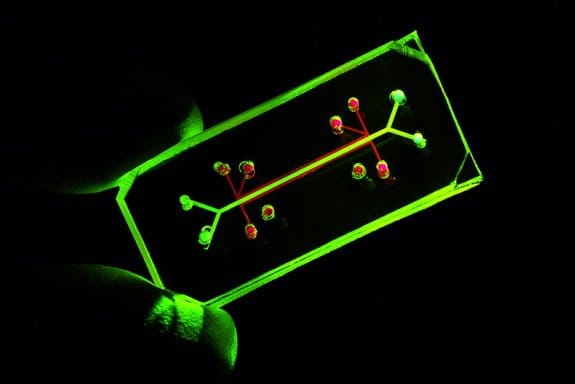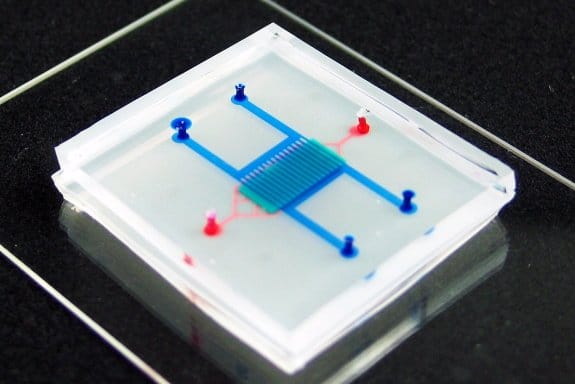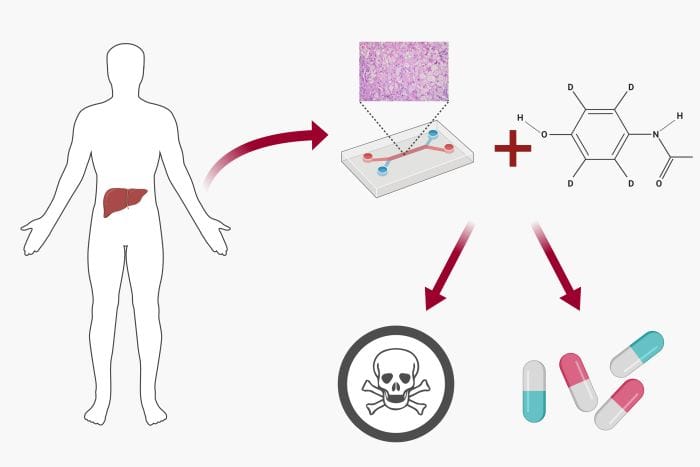
05 Jun A multiorgan human-on-a-chip system mimicking the immune system
A group of researchers has now taken organ on a chips to a new level by developing a multiorgan system with circulating immune cells to mimic the immunosurveillance process. The results of this study that hinged upon a three organ microfluidic chip are reported in a recent article published in the Advanced Science journal.
What is Organ-on-a-Chip?
Organ on a chips are tiny devices, usually smaller than the palm of a hand, that employ microfluidics to create microchannels and chambers at the micron-scale size for cell culturing in a microenvironment similar to that of the cell’s natural habitat. The chips are sealed and sterile and made of an optically transparent material that allows visual and real-time monitoring and analysis of the cells.
In principle, an organ on a chip consists of a main microchamber. The chamber is microfabricated using a biocompatible material such as PDMS. The microchamber is often connected to multiple side microchannel. These side channels are often connected to a fluidic delivery system and serve multiple purposes. They can be used to deliver nutrients, bacteria, viruses, and chemicals to the cells or wash the cells and discard the waste. Moreover, they can be employed to manipulate the cells mechanically or electrically.
An integrated immune system-on-a-chip
The immune system communicates with other organs of the body to fight infection and kill pathogens via various mechanisms. Monocytes are a crucial component in the immune system that are involved in many immune system responses and are used as representatives of the immune system in this human-on-a-chip platform.
The reported multiorgan microfluidic device includes three separate compartments involving the liver, cardiomyocyte, and skeletal muscle cells. This immune system-on-a-chip platform features monocytes as representative of the immune system which circulate through the three compartments of the system.

Reproduced under Creative Commons License
“The introduction of a recirculating immune component in a human-on-a-chip platform allows this system to monitor complex cell behavior and tissue–immune cell interactions in response to drug treatment.”
This proposed microfluidic platform holds key advantages as a drug toxicity screening platform. It is capable of monitoring intricate cell behaviors and complex immune system responses cytokines and signal molecules. “Another advantage of this multiorgan, microphysiological system is that it more accurately mimics in vivo conditions when compared to static monocultures (e.g., circulation, cell–cell interactions, and defined medium conditions).”
This multiorgan human on a chip was used for investigating the THP-1 cells (a cell line for modeling monocytes) response to cytokines and signaling molecules produced by tissues that directly or indirectly activate monocytes. Although the chips were tested with THP-1 cells, they can be modified to encompass other immune system components such either in isolation or in combination with other cells.
Read the original article: Differential monocyte actuation in a three‐organ functional innate immune system‐on‐a‐chip

Pouriya Bayat
Pouriya is a microfluidic production engineer at uFluidix. He received his B.Sc. and M.A.Sc. both in Mechanical Engineering from Isfahan University of Technology and York University, respectively. During his master's studies, he had the chance to learn the foundations of microfluidic technology at ACUTE Lab where he focused on designing microfluidic platforms for cell washing and isolation. Upon graduation, he joined uFluidix to even further enjoy designing, manufacturing, and experimenting with microfluidic chips. In his free time, you might find him reading a psychology/philosophy/fantasy book while refilling his coffee every half an hour. Is there a must-read book in your mind, do not hesitate to hit him up with your to-read list.
Discover the advancements of the microfluidics approaches for recapitulating the brain function on brain-on-chip devices.
Heart-on-chip devices employ microfluidic technology and tissue engineering principles to create functional models of the heart.
In a liver-on-a-chip, a highly controlled cell culture environment is employed for drug toxicity screening and metabolism analysis.






